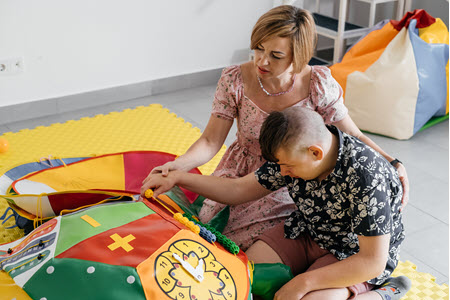RDSP – Registered Disability Savings Plan Who is it for? What are the benefits? What are the rules?
An RDSP is a savings plan designed to help ensure the long-term financial security of people with disabilitiesFor the purposes of this information, the term “person with a disability” means a person who is eligible for the disability tax credit..
Here is what you should know about RDSPs

What is an RDSP?
An RDSP is a savings vehicle designed to help provide long-term financial security to people with disabilities. Contributing to an RDSP does not provide a tax reduction, but the contributions may entitle the holder to grants paid directly into an RDSP.
The investment incomeInvestment income is the money that an investor earns through their investment. This money can be in the form of interest, a capital gain, etc. accumulates tax-free as long as it remains in the plan. The investment income earned and the grants received are taxable when they are withdrawn from the plan.
An RDSP may be used for the person with disabilities or for another beneficiary, such as a child or spouse.
The RDSP may be used, for example, to pay for home care or help for the beneficiary. You can contribute to an RDSP until the end of the year in which the beneficiary turns 59.
Several types of contributions can be made to an RDSP. For example:
- Amounts from a savings accountSavings is the amount of money you are able to set aside. It represents the difference between your income and your expenses.*
- Guaranteed Investment Certificates (GICs)A guaranteed investment certificate (GIC), also called a certificate of deposit or term deposit, is a security indicating that an investor has lent money to a financial institution. GICs earn interest. *
- Principal protected notesA principal protected note (PPN) is an investment usually guaranteed by a financial institution. It does not necessarily carry a fixed interest rate. Its rate can fluctuate according to an external factor, such as a stock market index.
- SharesA share, also referred to as stock, is an equity security that entitles you to an ownership interest in a company.
The company can distribute a portion of its earnings to shareholders by paying them a dividend.
The shares of companies listed on an exchange are bought and sold at the exchange.
When a company ceases to operate, the proceeds from the sale of its assets are used to pay its debts and taxes, and the rest of the money is distributed to shareholders. - BondsA bond is a security issued by governments and companies through which an investor lends money to the issuer.
In general, the government or company promises to pay the investor interest at a fixed rate and at certain intervals (for example, 2% per year). Interest is normally paid twice a year. At maturity, the government or company pays back a predetermined amount that is called the face value. The face value is usually $1,000.
There are several types of bonds:
Stripped bondReal return bondConvertible bondSavings bondRetractable bondUnsecured bondEtc. - Mutual fund unitsInvesting in a mutual fund gives the investor units in the mutual fund.
- Exchange-traded funds (ETFs)An exchange-traded fund (ETF) is an investment fund whose securities are traded on an exchange like shares.
These funds generally track a benchmark index. Unlike a mutual fund manager, an ETF manager does not seek to maximize the fund’s return but only to follow an index; this explains the typically lower management fees for ETFs.
* Money deposited in a savings account or GIC within an RDSP is protected up to $100,000, including principal and interest, if the deposit institution goes bankrupt. Visit the Deposit protection page to learn more.
The beneficiary of an RDSP
The beneficiary is the person for whom the money is invested. A beneficiary can have only one RDSP. To be the beneficiary of an RDSP, an individual must:
- Be eligible for the disability tax credit (DTC)
This link will open in a new window
- Have a social insurance number (SIN)
- Reside in Canada when the plan is set up
- Be under 60 years of age (some exceptions may apply)
The holder of an RDSP
The holder is the person who opens the RDSP. That person may contribute to the RDSP or authorize other people to contribute to it on their behalf.
If the beneficiary has reached the age of majority and is competent to enter into a contract, they may be both the beneficiary and the holder of the RDSP. Otherwise, the holder is a person or body legally authorized to act on behalf of the beneficiary. An RDSP may have more than one holder.

How do withdrawals work?
- The money in the RDSP belongs to the beneficiary. The money may therefore be:
- Withdrawn and used by the beneficiary, or
- Withdrawn by the holder and used for the beneficiary (for example, for home care or help)
- Amounts withdrawn from an RDSP do not affect the amounts received under certain income-based benefits such as the Canada child benefit (CCB) and the GST credit.
How do contributions to an RDSP work?
- Only the holder (or a person with written permission from the plan holder) may contribute to the RDSP.
- The contributions belong to the beneficiary, even if they are not made by the beneficiary.
- The lifetime contribution limit is $200,000.
- There is no annual contribution limit.
- The cut-off date for making contributions is December 31 of the year in which the beneficiary turns 59 years old.
RDSP and income tax
- Contribute to an RDSP
No tax deduction. However, contributions to an RDSP could be valid toward grants paid directly into an RDSP. - Receive a grant in an RDSP
No income tax to be paid as long as the grant remains in the RDSP - Earn investment incomeInvestment income is the money that an investor earns through their investment. This money can be in the form of interest, a capital gain, etc.
Tax-deferred while in the RDSP
- Withdraw funds equivalent to prior RDSP contributions
No income tax payable - Withdraw RDSP funds equivalent to government grants and investment income
These amounts belong to the beneficiary and will be added to taxable income. The beneficiary may therefore have to pay taxes on them.
What government assistance is available?
RDSPs are eligible to receive two types of government assistance:
- The Canada Disability Savings Grant (CDSG)
The CDSG can be as much as $3,500 per year (or $70,000 lifetime), depending on the amount contributed and the beneficiary’s family incomeFamily income is the total of all of a family’s income (salaries, investment income, etc.), including that of minor children.. - The Canada Disability Savings Bond (CDSB)
The CDSB is offered solely to low-income and modest-income Canadians. It provides a maximum of $1,000 per year (or $20,000 lifetime). No contribution is required to receive the bond. You simply need to open an RDSP.
Did you know?
- Government disability plan grants and bonds are paid until the end of the year in which the beneficiary turns 49.
- The amounts invested in the RDSP must stay in the plan for at least 10 years. If funds are withdrawn earlier, then a portion of the grants and bonds must be paid back (proportional
This link will open in a new window repayment rule). There is an exception if a beneficiary has a life expectancy of five years or less.
- A beneficiary may be eligible to receive one or both types of assistance.
EXAMPLE: Amounts accumulated in an RDSP at age 49 after contributing $1,500 per year from age 1 to age 20
Situation of a couple with a child who has a disability.
- Their adjusted family net incomeFamily income is the total of all of a family’s income (salaries, investment income, etc.), including that of minor children.: $80,000 per year
- Their contribution: $1,500 per year from 1 year of age until the child turns 20.
- Total contribution: $30,000
Since the couple’s income is above the low income cut-off determined by the government of Canada This link will open in a new window, they aren’t eligible for the CDSB. However, beginning the year the beneficiary turns 19, eligibility for the CDSB is based on the beneficiary’s income.
Assuming the child has a low income, he will be eligible for assistance. The following are the amounts that the government will add to the RDSP over the years:
- Grant of $3,500 per year (based on the contribution and adjusted family net income). The lifetime maximum is $70,000.
- Bond of $1,000 per year beginning at age 19. The lifetime maximum is $20,000.
Assuming an annual return of 5%, the parents’ $30,000 contribution will allow their child to accumulate $760,442 by age 49:
- Contributions: $30,000
- Grants and bonds: $90,000
- Return on investments: $640,442
Please see the table of amounts accumulated year after year
| Age | Contributions | Grants | Bonds | Annual return: 3% | Annual return: 5% | Annual return: 7% |
|---|---|---|---|---|---|---|
1 year | $1,500 | $3,500 | $0 | $5,097 | $5,161 | $5,225 |
2 years | $1,500 | $3,500 | $0 | $10,347 | $10,581 | $10,817 |
3 years | $1,500 | $3,500 | $0 | $15,755 | $16,271 | $16,799 |
4 years | $1,500 | $3,500 | $0 | $21,324 | $22,246 | $23,201 |
5 years | $1,500 | $3,500 | $0 | $27,061 | $28,520 | $30,050 |
6 years | $1,500 | $3,500 | $0 | $32,970 | $35,108 | $37,379 |
7 years | $1,500 | $3,500 | $0 | $39,056 | $42,024 | $45,221 |
8 years | $1,500 | $3,500 | $0 | $45,325 | $49,287 | $53,612 |
9 years | $1,500 | $3,500 | $0 | $51,782 | $56,913 | $62,590 |
10 years | $1,500 | $3,500 | $0 | $58,433 | $64,920 | $72,197 |
11 years | $1,500 | $3,500 | $0 | $65,283 | $73,327 | $82,476 |
12 years | $1,500 | $3,500 | $0 | $72,338 | $82,155 | $93,475 |
13 years | $1,500 | $3,500 | $0 | $79,606 | $91,424 | $105,243 |
14 years | $1,500 | $3,500 | $0 | $87,091 | $101,157 | $117,836 |
15 years | $1,500 | $3,500 | $0 | $94,801 | $111,376 | $131,310 |
16 years | $1,500 | $3,500 | $0 | $102,742 | $122,107 | $145,727 |
17 years | $1,500 | $3,500 | $0 | $110,921 | $133,373 | $161,153 |
18 years | $1,500 | $3,500 | $0 | $119,346 | $145,203 | $177,660 |
19 years | $1,500 | $3,500 | $1,000 | $129,038 | $158,650 | $196,356 |
20 years | $1,500 | $3,500 | $1,000 | $172,768 | $172,768 | $216,360 |
21 years | $0 | $0 | $1,000 | $144,207 | $182,431 | $232,540 |
22 years | $0 | $0 | $1,000 | $149,548 | $192,578 | $249,852 |
23 years | $0 | $0 | $1,000 | $155,050 | $203,231 | $268,376 |
24 years | $0 | $0 | $1,000 | $160,716 | $214,418 | $288,197 |
25 years | $0 | $0 | $1,000 | $166,552 | $226,163 | $309,405 |
26 years | $0 | $0 | $1,000 | $172,564 | $238,496 | $332,098 |
27 years | $0 | $0 | $1,000 | $178,756 | $251,445 | $356,379 |
28 years | $0 | $0 | $1,000 | $185,133 | $265,042 | $382,360 |
29 years | $0 | $0 | $1,000 | $191,702 | $279,319 | $410,160 |
30years | $0 | $0 | $1,000 | $198,468 | $294,310 | $439,905 |
31 years | $0 | $0 | $1,000 | $205,437 | $310,050 | $471,733 |
32 years | $0 | $0 | $1,000 | $212,615 | $326,577 | $505,789 |
33 years | $0 | $0 | $1,000 | $220,008 | $343,931 | $542,228 |
34 years | $0 | $0 | $1,000 | $227,623 | $362,152 | $581,219 |
35 years | $0 | $0 | $1,000 | $235,467 | $381,284 | $622,938 |
36 years | $0 | $0 | $1,000 | $243,546 | $401,373 | $667,578 |
37 years | $0 | $0 | $1,000 | $251,867 | $422,467 | $715,343 |
38 years | $0 | $0 | $1,000 | $260,438 | $444,615 | $766,452 |
39 years | $0 | $0 | $0 | $268,251 | $466,845 | $820,103 |
40 years | $0 | $0 | $0 | $276,299 | $490,188 | $877,511 |
41 years | $0 | $0 | $0 | $284,588 | $514,697 | $938,936 |
42 years | $0 | $0 | $0 | $293,125 | $540,432 | $1,004,662 |
43 years | $0 | $0 | $0 | $301,919 | $567,454 | $1,074,988 |
44 years | $0 | $0 | $0 | $310,976 | $595,826 | $1,150,237 |
45 years | $0 | $0 | $0 | $320,306 | $625,618 | $1,230,754 |
46 years | $0 | $0 | $0 | $329,915 | $656,898 | $1,316,907 |
47 years | $0 | $0 | $0 | $339,812 | $689,743 | $1,409,090 |
48 years | $0 | $0 | $0 | $350,007 | $724,230 | $1,507,727 |
49 years | $0 | $0 | $0 | $360,507 | $760,442 | $1,613,268 |
Total | $30,000 | $70,000 | $20,000 | $360,507 | $760,442 | $1,613,268 |

This graph, in which the vertical axis indicates amounts accumulated between $0 and $1,700,000, shows that after 49 years:
- At an annual rate of return of 3%, with total contributions of $30,000 and total grants and bonds of $90,000, the return on investment is $240,507.
- At an annual rate of return of 5%, with total contributions of $30,000 and total grants and bonds of $90,000, the return on investment is $640,442.
- At an annual rate of return of 7%, with total contributions of $30,000 and total grants and bonds of $90,000, the return on investment is $1,493,268.

What happens when the beneficiary dies?
- The total amount of grants and bonds received in the last 10 years preceding the beneficiary’s death must be paid back.
- The amount remaining in the RDSP after repayment is paid to the beneficiary’s estateThe beneficiary is the person who will receive insurance benefits (money paid by the insurer). For example, the beneficiary of a life insurance policy is the person who will receive the money if the insured dies. (successionThe succession is the transmission of a deceased person’s patrimony (assets) to their heirs. The term is also used to designate the patrimony that is passed on to them.).
Which financial institutions offer RDSPs?
For a list of financial institutions that offer RDSPs, visit the Employment and Social Development Canada website This link will open in a new window.
To ensure that you're dealing with an authorized person and firm, consult the register of firms and individuals authorized to practise, or call the AMF Information Centre.
End of the insight
Le temps, c'est de l'argent! This link will open in a new window (in French only)
Le rendement, c'est important! This link will open in a new window (in French only)
Choosing Investments (pdf - 1 MB)This link will open in a new windowUpdated on June 17, 2022
Where to find more information
For the Canada Disability Savings Grant or the Canada Disability Savings Bond: visit the Employment and Social Development Canada This link will open in a new window website. If you use a teletypewriter (TTY), call 1 800 926-9105.
